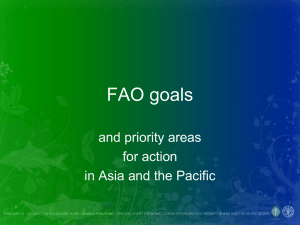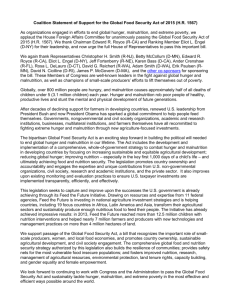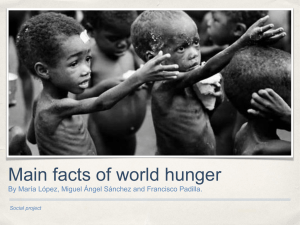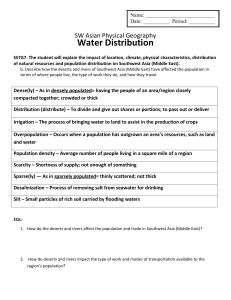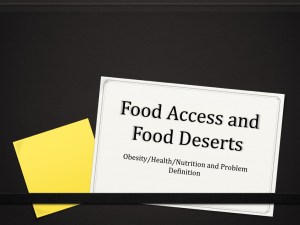Amy Shaw - Furman University
advertisement
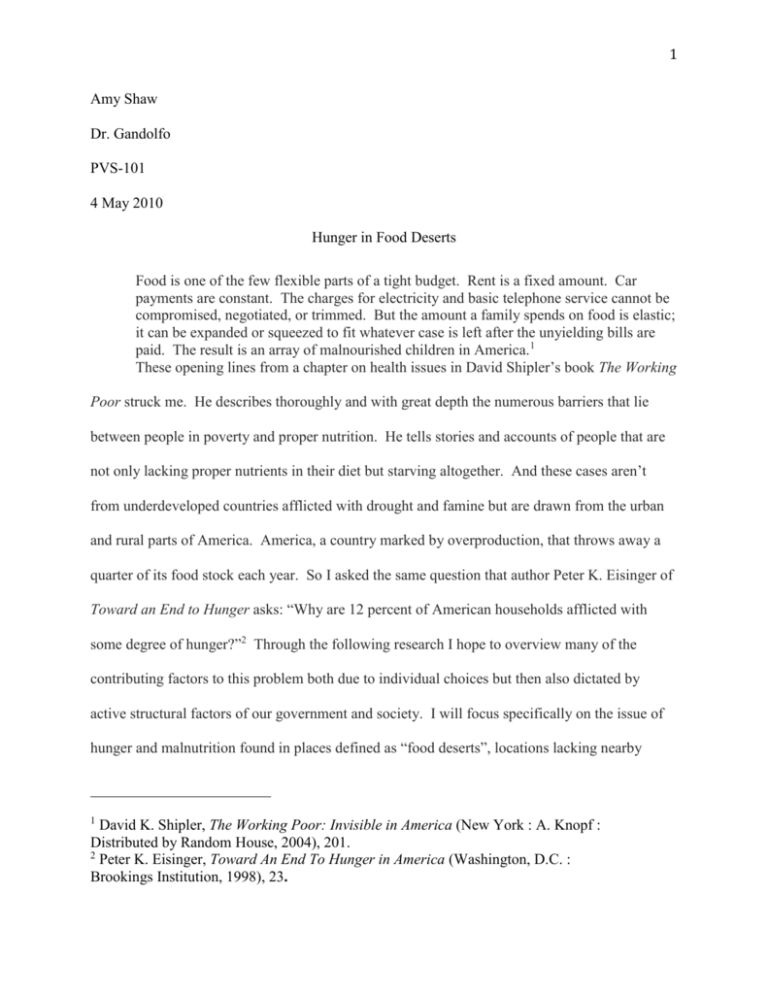
1 Amy Shaw Dr. Gandolfo PVS-101 4 May 2010 Hunger in Food Deserts Food is one of the few flexible parts of a tight budget. Rent is a fixed amount. Car payments are constant. The charges for electricity and basic telephone service cannot be compromised, negotiated, or trimmed. But the amount a family spends on food is elastic; it can be expanded or squeezed to fit whatever case is left after the unyielding bills are paid. The result is an array of malnourished children in America.1 These opening lines from a chapter on health issues in David Shipler’s book The Working Poor struck me. He describes thoroughly and with great depth the numerous barriers that lie between people in poverty and proper nutrition. He tells stories and accounts of people that are not only lacking proper nutrients in their diet but starving altogether. And these cases aren’t from underdeveloped countries afflicted with drought and famine but are drawn from the urban and rural parts of America. America, a country marked by overproduction, that throws away a quarter of its food stock each year. So I asked the same question that author Peter K. Eisinger of Toward an End to Hunger asks: “Why are 12 percent of American households afflicted with some degree of hunger?”2 Through the following research I hope to overview many of the contributing factors to this problem both due to individual choices but then also dictated by active structural factors of our government and society. I will focus specifically on the issue of hunger and malnutrition found in places defined as “food deserts”, locations lacking nearby 1 David K. Shipler, The Working Poor: Invisible in America (New York : A. Knopf : Distributed by Random House, 2004), 201. 2 Peter K. Eisinger, Toward An End To Hunger in America (Washington, D.C. : Brookings Institution, 1998), 23. 2 supermarkets. I will also overview the negative affects of these setting, void of fresh, healthy food on their inhabitants and cite the actions needing to take place to ensure their eradication. Before explaining the problem of food deserts, the fundamental issue of hunger present in the United States must be defined. Merriam Webster defines hunger as “a craving or urgent need for food or a specific nutrient” and “a weakened condition brought about by prolonged lack of food”3. According to the 1997 Census Bureau’s Current Population Survey eleven million admitted to be victims of such hunger, being put into the Census’ part of the population that is “food insecure with hunger”. In addition to those eleven million, an additional twenty three million people can be labeled “food insecure without hunger.” They are not suffering from hunger but the sufficiency of their food supply is questionable and their diets conformed to a deficiency of funds.4 This label of “food insecure” has been adopted and is more readily used than “hungry”. People find that “food insecurity” with and without hunger eliminates much of the vagueness surrounding the term “hunger” and the specific bar that it is measured for individuals. Food insecurity also addresses the issue of malnutrition as a both an affect and separate type of hunger. Shipler points out the connection in the following quote: “Surveying food’s insufficient quantity, rather than its quality, may leave uncounted a larger number of families who would not label themselves ‘food insecure’ but have children lacking nutrients vital to healthy brain development”5. Although the Census Surveys provide estimates of Americans affected by the pain of hunger, they can only begin to account for those whose health suffer from resulting malnutrition. And completely exempt from the numbers are the millions of people in Merriam-Webster's Collegiate Dictionary, 11th ed., s.v. “hunger.” 4 Eisinger, 25. 5 Shipler, 216. 3 3 our country who are malnourished while over consuming or consuming the improper types of calories. With health issues such as diabetes and cardiovascular disease abundant in our society, malnutrition becomes a key issue to be addressed. Especially in areas defined as “food deserts” where by definition malnutrition marks the population, people’s dietary intakes must be examined in order for corrective measure allowing healthier eating to take place. Malnutrition is specifically defined as “faulty nutrition due to inadequate or unbalanced intake of nutrients or their impaired assimilation or utilization”6. Over-consumption malnutrition in particular is ascribed to a larger scale dietary trend. In the following excerpt from Anthropology and Contemporary Human Problems they define an overview of this trend titled global trend titled the “nutrition transition” as: …the pervasive change from diets rich in complex carbohydrates, whole grains, and vegetables to diets based on fats and simple carbohydrates, or sugars. The nutrition’s transition, which seems to be an intrinsic feature of the global market economy, is a circular process in which the development of capitalist commercial enterprises causes social changes that over-stimulate the natural human appetite for fat and sweets and provide the commodities and the incomes to meet the almost unrestrained demand.7 This text goes on to attribute blame for this transition specifically to increased advertising of unhealthy foods and a significant disposable income. However the nutrition transition is not limited to any particular society but expands to all corners through common media messages, cultural trends, and structural barriers in place. For example, John H. Bodley author of Anthropology and Contemporary Human Problems specifically explains the exponential effects of overconsumption on residents of urban Merriam-Webster's Collegiate Dictionary, 11th ed., s.v. “malnutrition.” 7 John H. Bodley, Anthropology and Contemporary Human Problems (Lanham, MD: Alta Mira Press, 2008), 148. 6 4 areas, often living in poverty. For this massive conversion to deficient diets he attributes responsibility to several cultural activities occurring solely within cities. The flight of people to cities seeking employment that takes them out of the home leaving less time for meal preparation, has “dramatically increased the worldwide appeal of and market for highly processed and packaged convenience foods, as well as ‘fast foods’ that are high in fat and sugar and low in nutrients”8. Study after study reaffirms this universal urban desire for quick and convenient food, most often leading to heavily processed, unhealthy meals. For example The Atlas of Food: Who Eats What, Where, and Why authors similarly observe “processed food appeals to consumers because it saves time, with the preparation and most of the cooking done in the factory”9. These foods completely void of the nutrients found in fresh produce and meat and replaced with a higher proportion of sugar and fats are major contributors to both malnutrition caused by hunger and overconsumption. Bodley lastly observes how the effects of this disproportionate consumption are expounded through the predominantly sedentary lifestyle of a non-rural lifestyle.10 The daily activities and careers of people residing within cites are marked by limited time for meal preparation, an influx of unhealthy food advertisements and options, and a less active way of life often due to a desk job only and largely contribute to the “nutrition transition” taking place globally. Although multiple factors hinder healthy eating for those living in urban areas, this could not be truer than for those living in poverty. Also bombarded with poor media messages and having little time between multiple jobs to prepare meals, people of this socioeconomic class are even more limited in their food options because of lack of finances. For many lack of funds means not having a proper kitchen to 8 Bodley, 148. Erik Millstone and Tim Lang, The Atlas of Food: Who Eats What, Where, and Why (Berkeley: University of California Press, 2008), 84. 9 10 Bodley, 148. 5 prepare meals or even store and preserve foods. Shipler further describes this reality in the following quote from The Working Poor: “Some slumlords won’t replace malfunctioning refrigerators, which won’t keep milk cold enough. Some families are crammed into shared apartments where the single fridge is rifled by residents who steal others’ food”11. While the ability to prepare meals from grocery store purchases often dictates the poor’s food consumption options, they first have to overcome the even larger obstacle of obtaining these groceries. Lack of accessibility to supermarkets in cities is a problem felt by all residents but specifically those in poverty. Low-income neighborhoods more often lack places to buy fresh produce and people then must turn to the more accessible options such as fast food restaurants and convenience stores. These areas defined as “food deserts” present in much of America deprive those in poverty of the opportunity to a healthy diet and active measures must be taken to ensure their elimination. This term “food deserts”, new to many, has been increasingly used in recent legislation and because so, more clearly defined for the public and politicians as they become aware of the issue. David C. Holzman defines food deserts as the following in his recent article on the current administration’s approach to problem: “The term ‘food desert’ refers to areas that, although often served by fast food restaurants and convenience stores, lack easy access to affordable fruits, vegetables, whole grains, low-fat milk, and other foods that make up the full range of a healthy diet”.12 According to this definition, 23.5 million Americans currently live in these locations described above that are at least one mile from a supermarket. Food deserts consistently show up more often in poverty marked areas not only in cities but also in the poor low-income rural sections of the United States. For example, in the Delta region of Mississippi, there is only on average a single supermarket per 11 Shipler, 207. 12 David C. Holzman, “White House Proposes Healthy Food Financing Initiative.” (Environmental Health Perspectives, 118:a156-a156. doi:10.1289/ehp.118-a156) 6 190.5 square miles, leaving more than seventy percent of the people in the area commuting thirty miles or sometimes more to reach a supermarket13. And as for cities, in New York in middle class neighborhood there is one supermarket for every 5,800 people where in the most impoverished parts of Brooklyn there is only one per every 63,000 people.14 These dramatic disparities existing all over the country are also largely due to the trend in the retail industry from locally owned store to chains such as Wal-Mart and other major grocers. As they gain further power and ability to lower prices even more, smaller “mom and pop” options can no longer compete and are forced to shut down. According to an article in Remaking the North American Food System: Strategies for Sustainability “the number of supermarket and grocery store in the United States declined from 73,357 in 1992 to 69,461 in 1997, representing a 5 percent decline in the number of stores”15 . With each closure a food buying option is eliminated, most often further distancing consumers from retailers. The lack of full service grocery stores in impoverished areas has many negative implications but is made manifest to the poor especially in two ways: price and transportation. As simply put in Remaking the North American Food System: Strategies for Sustainability “For many residents of the United States purchasing groceries is a minor inconvenience rather than a major obstacle”16. While cost of food and the commute to the grocery store are influencing factors on most people’s food choices, they are not the ultimate determiners of entire diets as are with those lacking sufficient incomes. Furthermore while research clearly establishes that those in poverty have noticeably fewer healthy food options, it also shows how they have to pay even more than those outside of poverty. On average poor people pay 8.8 percent more per year on 13 C. Clare Hinrichs and Thomas A. Lyson, eds., Remaking the North American Food System: Strategies for Sustainability (Lincoln: University of Nebraska Press, 2007), 201. Eisinger, 30 Hinrich and Lyson, 202. 16 Hinrichs, 201. 14 15 7 groceries than people who reside above the poverty line17. Many factors combine to produce these inflated prices found on the shelves of convenience store and the few and far between supermarkets of food deserts. For one, the lower number of stores means less competition. With less competition among retailers there is less incentive to adhere to common market practices and price points and even more little incentive for more competitors to move into the area. Low rate of return on investment, inability to keep adequate staff, and finding adequate locations often within cities are just a few reasons cited in the book The Ghetto Marketplace for the “by the highest levels of the Administration in Washington, to do more in the area of opening modern supermarkets in low-income, urban areas”18 as far as urging supermarket industries. This idea of government intervention is put forth in this book in 1969 and still forty years later, the best models to encourage retailers to enter these economically unappealing areas is under debate. While limited number of grocery store directly affects prices paid by consumers in these area they are also adversely affected by the longer distances between their homes and stores. This commute is often times the deciding factor between choosing to trek to the store, haul groceries home, then prepare a meal or simply stopping by a more conveniently located fast food restaurant. Populations less likely to own cars must travel further distances often with additional costs from public transportation or even taxi services. Even if the cheaper option of public transportation is available, due to poor city planning lines frequently do not provide access to grocery store. While the cost and distance of inner city stores often seems the most significant burden to those in poverty, this fails to acknowledge the long term effects of food consumption choices. Although the cost and burden of an expensive and laborious trip to the grocery store are immediately felt, the malnutrition caused by the constant preference of convenience store food and fast food meals options is felt over a longer period of time. According to a report from the White House the 17 18 Eisinger, 24. Frederick D. Sturdivant, The Ghetto Marketplace (New York: Free Press, 1969), 75. 8 government spends “$150 billion every year to treat obesity-related conditions, and that number is growing”19 and that does not even begin to include the incredible amounts of funds allotted for those not consuming enough calories. As malnutrition is examined and attempted to be corrected in the United States it makes sense to evaluate restaurant industry, which most often draws people away from the produce aisle and provides them with oversized portions of food lacking nutritional value. The Atlas of Food notes that American spend almost $2,500 a year per person on eating outside the home, which includes those with little disposable income where “in most advanced economies there are many opportunities for eating out at a low cost…where many homes may be without a kitchen, there is considerable demand for low-cost cooked food readily available in the street”20. The authors of The Food Atlas also make the insightful correlation between the rise of convenience and fast food and the presence of the traditional mealtime shared between family and friends. They point out that this food often brought home in favor of preparing a meal too often ends up being consumed in front of the TV replacing the act of eating a meal with mere “grazing”21. Lost relational opportunities and innutritious diets caused by the constant choice of convenience and conceding to popular yet unhealthy trends in food consumption has all contributed to a poorer health of those living in food deserts. Summed up in an article on Remaking the North American Food System: Strategies for Sustainability the following quote explains the problems and need for change in these areas. The key implication of the food desert dynamic is that populations such as the poor and the less educated already experiencing high risk of poor dietary intake and nutrition-related illness may experience even greater risks as a result of living in a food desert.22 Holzman. Millstone, 94. 21 Millstone, 94. 22 Hinrichs, 213-214. 19 20 9 While the negative effects of the presence of food deserts on the poor in America has been discussed, it is what can be done about the problem that is the most popular conversation currently taking place in the White House. With the inauguration of President Barrack Obama the food discussion, currently building momentum, also has a place in legislation. With the creation of the White House Garden whose produce goes straight to the President’s family meal table an awareness of the benefits of local and organic grown foods has been made more public. But even more important to the eradication of food deserts, First Lady Michelle Obama has personally created the Lets Move! Initiative focused at bettering the health of Americans, specifically the 6.5 million children residing in food deserts. With financial backing from her husband she has created the ambitious goal of eradication all of these nutrition impoverished areas in only 7 years.23 In a video found on the White House website highlighting a urban supermarket opening necessary for canceling out one of these areas Michelle Obama says “we’re setting people up for failure unless we fix this”24. Shipler also realizes this injustice that afflicts specifically children as a reason for action. He cites the following reason as a call to action and better action. “The damage that malnutrition does to brain development and physical health is stealthy, because it precedes the retarded growth that usually sounds the alarm25”. Like other critics supporting government intervention, this facet of the issue targeting children, presents a similar belief of equal opportunity to healthy eating. Just as children should not be involuntarily harmed by poor nutrition due to their caregiver lack of finances or nutrition education, the impoverished population, as a whole should not be limited to unhealthy choices based on external structural causes. These external barriers to the possibility of healthy lifestyle such as lack 24 Holzman “Taking on ‘Food Deserts’”, posted by Cammi Croft. White House, 2010, Video recording. http://www.whitehouse.gov/blog/2010/02/24/taking-food-deserts. 25 Shipler, 215. 23 10 of knowledge and close affordable food should be eliminated with the aid of the government in order to provide a more equal opportunity for Americans not only to thrive, but merely survive. Firstly, Food deserts cannot be eliminated if the people living in these areas do not see a need for change. Through education especially within schools but also extending to all afflicted age groups should be made available for the issue of malnutrition to be breached. Information must be provided in support of healthy eating and its numerous positive effects. Furthermore, messages currently in place through popular cultural beliefs and commercial advertisements that encourage detrimental health issues must be exposed and explained in order for the positive education to hold any weight. With education actively working within the decisions made by those with severely limited budgets, there must also be many more food options in place and readily available. However these options are not often inexpensive and would have to be subsidized in order to jumpstarted. As earlier pointed out, few supermarket chains are eager to move into the poorer areas of towns. High property and insurance costs as well as limited sized land plots all discourage from initial building. Unqualified local management and staff as well as increased pilferage are also discouragements. Because of these obstacles there must be incentives in place through government funding to bring about change. As seen in Pennsylvania recent Fresh Food Financing Initiative state funds have encouraged the opening of “80 stores ranging from small mom-and-pop grocers to large full-service supermarkets, providing food for around 400,000 people”26. This program successful in not only adding food options to Pennsylvania is also directly attributed as a model for the national-wide Healthy Food Financing Initiative. This Initiative created by a $400 million dollar budget allotment from President Obama is a tier of his wife healthy living campaign. Created to function like Pennsylvania’s legislature in opening more supermarkets, it is also providing grants to farmers to encourage 26 Holzman 11 the local and community based food movement which can also have a great effect on the eradication of food deserts. While there is current momentum bringing hope to the problem of malnutrition in America, especially in impoverished communities, much more must be done to provide equality in health among the socioeconomic classes. The presence of wide spread health issues must specifically be targeted for those in poverty because it only continues to increase the disparity between rich and poor through short and long term costs. Enlightenment of the plight of the poor and how it affects their every decision is essential for society as a whole to give proper attention to their circumstances and work to alleviate them of such hardships. Shipler reaffirms this reality when he says, “…There’s this continuum where the problems that would be real but not overwhelming in a framework of economic security become overwhelming and catastrophic in an impoverished home”27. Food, while a small and flexible item confined to deficient budget, hold great consequence both in the short an long run often gets pushed aside, abused, or neglected all together. 27 Shipler, 211. 12 Bibliography Bodley, John H., Anthropology and Contemporary Human Problems. Lanham, MD: Alta Mira Press, 2008. Eisinger, Peter K., Toward An End To Hunger in America. Washington, D.C. : Brookings Institution, 1998) Hinrichs, C. Clare and Thomas A. Lyson, eds., Remaking the North American Food System: Strategies for Sustainability. Lincoln: University of Nebraska Press, 2007. Holzman, David C., “White House Proposes Healthy Food Financing Initiative. Environ Health Perspect” 118:a156-a156. doi:10.1289/ehp.118-a156 Millstone, Erik and Tim Lang, The Atlas of Food: Who Eats What, Where, and Why. Berkeley : University of California Press, 2008 Root, Waverly, and Richard de Rochemont. Eating in America: A History. New York: Morrow, 1976. Sturdivant, Frederick D., The Ghetto Marketplace. New York: Free Press, 1969. Shipler, David K., The Working Poor: Invisible in America. New York : A. Knopf : Distributed by Random House, 2004 13 “Taking on ‘Food Deserts’”, posted by Cammi Croft. White House, 2010, Video recording. http://www.whitehouse.gov/blog/2010/02/24/taking-food-deserts.

